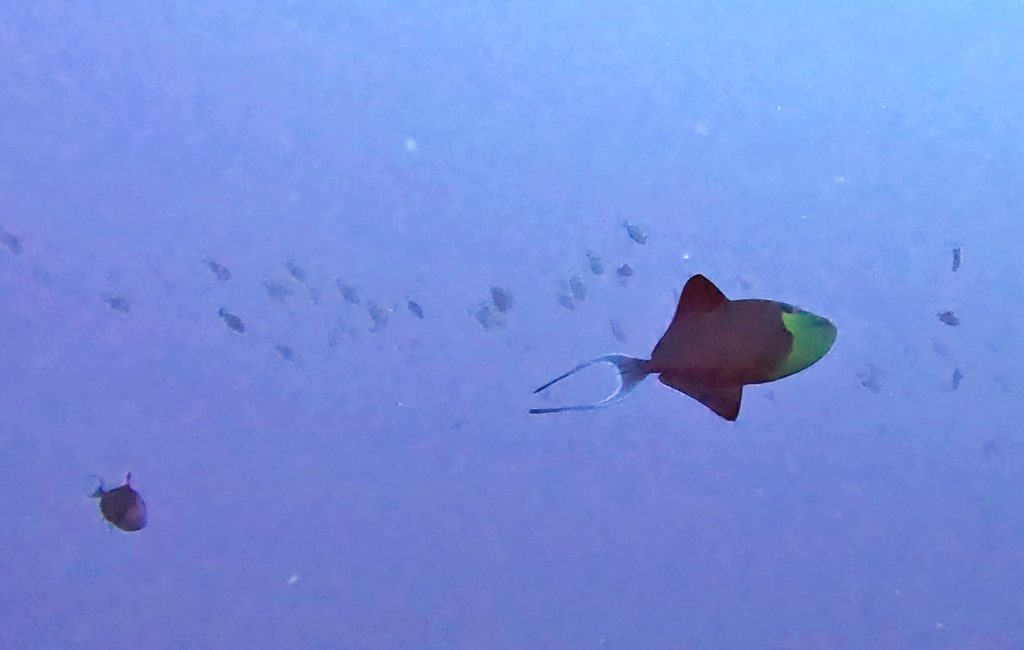We were still trying to get Jazz’s regulator working, and a guy from Top Dive spent some time with us working out how to fix it. In the end, we opted to borrow a second stage from Mel and Brian on Sava again, and as they were headed to Tahiti, they let us hold onto it for a couple of weeks. Gear sorted, we hopped on a boat with Top Dive and headed out to the pass, about a mile from town. Video first, lest we bury the lede.
The first dive started outside the pass, where we dropped down to about 80 feet and swam along the reef. The guide was super excited about the manta rays that were swimming by, though they were about 40 feet deeper. We couldn’t descend that far ourselves, as we were diving with Nitrox, so we had to be content to watch them from a distance. There were several groups all trying to watch the mantas from about the same spot, so it felt a little like a crowded stadium; a very odd experience.


We had, however, seen our fill of reef mantas up close and personal in Tahuata, so we turned our backs on them much earlier than the rest of the group, and checked out things on the reef. Like this grouper getting a deep cleaning from a pair of wrasses, and this big intermediate-phase napoleon.


Or this little crab, waving its arms around deep inside this coral.


There were lots of these two varieties of what we found out are hawkfish (so named because they perch on the coral.) Arc-eye on the left (these names!), freckled on the right.


This one was super weird-looking, a leopard wrasse. Right, a slender lizardfish.


Back in the blue, there were lots of these triggerfish, and some really big balls of snapper.


There were lots of different butterfly fish, like these pyramids left, or the fourspot butterflyfish top right. Also pictured, a juvenile pacific sailfin tang, with its huge fins spread wide.



We were starting to ascend into the pass when we ran into these two: a peacock flounder, and a spiky thing we got all excited about and which turned out to be a (toxic, invasive) crown of thorns starfish.


We passed over some sandy territory that was full of cushion stars, in all different colors. At this point we were half crawling across the rubble floor, trying to make it across the current into the next section. Andrew had to share air as he’d blown too much chasing the big grouper at the cleaning station.




As we drifted through the pass, there were a number of valleys and cuts, where we could drop down out of the current and see sleeping sharks and other fish. Here’s a grouper, some wrasses, and a couple types of snapper.





The second dive, we were headed for Alibaba Canyon, a shark observatory. We dropped down and drifted by some sharks, as well as this anemone and its attendant orangefin anemonefish.


We had to crawl across the current to get where we were going, but eventually we arrived at the canyon, and were rewarded with sharks.


From there, we held on (to dead coral only!) and watched the show (and the deco countdown on our watches). The sharks drifted by, swimming gently into the current, then looping around to join the dance again. The more we held still, the closer they got. It was awesome.













We stayed there until we started to approach our decompression limits, about fifteen minutes of shark-watching and shivering. When the deadline approached, we let go of our perches and started to ascend into the current… which immediately whisked us away! While we could have stayed longer just a little shallower, there was no way to stay anywhere near the reef, so we slowly ascended to our safety stop, and sat at 15 feet while the reef raced by below us. Our ascent probably took less than ten minutes and brought us a half mile into the lagoon. It’s times like this when you’re really happy to have boat support: our guide inflated a surface buoy and the boat picked us up as we surfaced.
